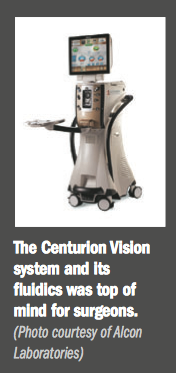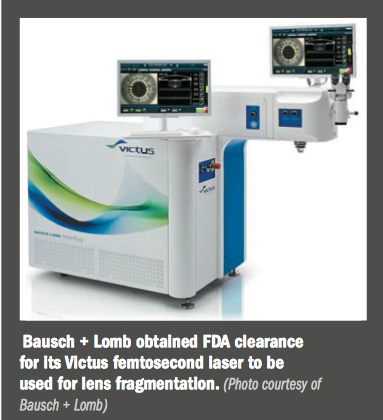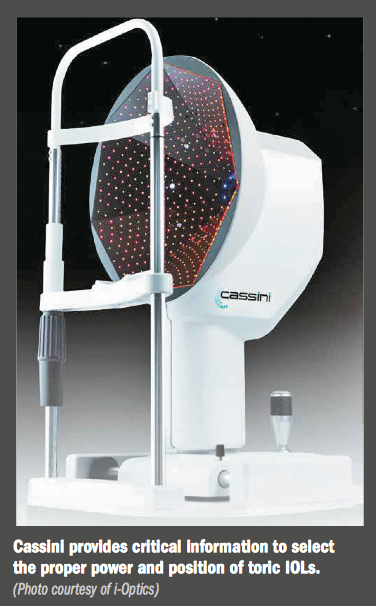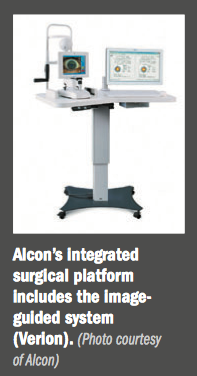Article
Cataract surgery hot topics carry over into 2014 and beyond for physicians
Innovations in femtosecond laser-assisted cataract surgery and microinvasive glaucoma surgery continue to drive the momentum of cataract procedures into 2015.
Take home
Innovations in femtosecond laser-assisted cataract surgery and microinvasive glaucoma surgery continue to drive the momentum of cataract procedures into 2015.
By Cheryl Guttman Krader; Reviewed by Malik Kahook, MD, Randall Olson, MD, and Mark Packer, MD
The introduction by Alcon Laboratories of the Centurion Vision System was one of the biggest news items in cataract surgery in 2013, and it continued to take center stage in 2014 as real world clinical experience affirmed the benefits of its proprietary new fluidics system (Active Fluidic Technology).
More in this issue: Diagnostic technologies focus of industry acquisitions in 2014
Femtosecond laser-assisted cataract surgery (FLACS) also remained a major topic of discussion in 2014 despite a relative lack of breaking news.

Ophthalmology Timeseditorial advisory board members, Malik Kahook, MD, Randall Olson, MD, and Mark Packer, MD, spoke about these topics as part of an end-of-the-year review of cataract surgery.
Safer surgery
Although the Centurion Vision System offers several innovative attributes, its fluidics technology that allows surgeons to set and maintain a target IOP is considered one of its most outstanding features.
“We are developing some protocols to more rigorously evaluate the system’s performance and benefits, but it is obvious to me that this is very exciting technology and will be the new standard,” said Dr. Olson, professor and chair, department of ophthalmology and visual sciences and CEO, John A. Moran Eye Center, University of Utah, Salt Lake City.
He noted that the scientific program at the 2014 meeting of the American Academy of Ophthalmology (AAO) was lacking in research evaluating the new phacoemulsification system. However, positive findings were reported in studies presented at the 2014 meeting of the European Society of Cataract and Refractive Surgeons.
Dr. Olson noted that he and his colleagues at Moran Eye Center have done a lot of work evaluating phacoemulsification efficiency, and the results are sometimes surprising. For example, while it has been assumed that a Kelman-style tip would provide greater efficiency than a straight tip when using longitudinal ultrasound, the results from formal testing found the opposite was true.
In their research using objective endpoints, Dr. Olson and colleagues also showed that use of a Venturi pump system decreases chatter and improves efficiency relative to surgery performed with a peristaltic pump. The study, which is in agreement with other research and is being published in a forthcoming paper, demonstrated that with most grades of cataract, operating with a Venturi pump system reduced by half the time needed to remove nuclear material.
“It remains to be seen how the Centurion performs compared with a Venturi unit, but I think that at least in terms of its maintaining chamber stability, the Centurion is a major step up,” Dr. Olson said.
Dr. Kahook also commented on the improved anterior chamber stability provided by the Centurion Vision System, which he said has been installed in the operating room at his center for several months.
“With this system, there is better control over the actual pressure inside the eye and less fluctuation in the pressure,” said Dr. Kahook, The Slater Family Endowed Chair in Ophthalmology and Professor of Ophthalmology, University of Colorado, Denver. “The ability to avoid wide IOP fluctuations affords greater comfort for all patients, and the ability to modulate the IOP has safety implications for cataract surgery patients with glaucoma who cannot tolerate high IOP.”
Dr. Packer noted that pressurized infusion is not actually a brand new concept for phacoemulsification units as it was first found on the Millennium phacoemulsification system (Bausch + Lomb) and retained on the successor to the Millennium, the Stellaris Vision System (Bausch + Lomb). However, Dr. Packer said that Alcon successfully improved on what was already a great idea by introducing monitoring and feedback functions to maintain stable chamber pressure.
He added that in addition to its benefit for increasing surgical safety by reducing surge, the pressurized infusion technology is particularly useful for him and others who perform bimanual microincisional cataract surgery (MICS).
“The only way to achieve sufficient infusion with the smaller-aperture instruments used in bimanual MICS has been to use an extremely high bottle height,” explained Dr. Packer, who is in private practice, Boulder, CO, and clinical associate professor of ophthalmology, Oregon Health & Science University, Portland. “However, the ability to do so may be limited, depending on the ceiling height of the operating room.”
Femtosecond laser market
Overall, the cataract surgery femtosecond laser market demonstrated signs of maturity in 2014. Bausch + Lomb obtained FDA clearance for its Victus femtosecond laser to be used for lens fragmentation. Otherwise, there were no major news announcements in terms of platform developments or upgrades. However, the number of studies on FLACS continued to grow and fueled the discussion on its role.

“Looking at the literature, we are seeing more publications reporting that FLACS reduces phaco energy utilization and perhaps increases surgical efficiency once the cataract removal portion of the procedure starts,” Dr. Kahook said. “However, there are an equal number of reports describing how FLACS slows us down in the operating room, and debate about its benefits continues.”
From Dr. Packer’s point of view, there are cynics and naysayers who continue to express their concerns and criticisms about FLACS. However, he believes that some of the initial resistance to femtosecond lasers that was related to the cost of the equipment is diminishing. Dr. Packer suggested the shift may be due in part to the fact that a growing number of cataract surgeons appear to be doing very well financially by offering FLACS.
“There are surgeons reporting that FLACS is driving adoption of premium surgery in their practices. As a result, they are finding that the laser is not just affordable but rather that it is increasing their profitability,” Dr. Packer explained.
“Initial anxiety over whether it will be possible to make ends meet after such an expensive capital outlay may quickly be replaced by a commitment to be successful and excitement about the potential benefits of FLACS. That excitement gets communicated to patients with the end result being higher conversion rates to premium surgery and a healthier bottom line.”
Dr. Packer noted that safety concerns relating to increased risk of anterior capsule tears when using the femtosecond laser for capsulorhexis seem to have been mollified thanks to modifications in laser parameters and surgical technique.
“The reports about capsule tears led to suggestions for adjusting the laser settings by reducing the power and placing the spots closer together in order to create finer perforations. In addition, surgeons are increasing the size of the capsulotomy to avoid tears. Previously, some surgeons were creating a 4.5 or 4.7 mm opening with the laser, but that diameter is a little small to work through safely, even if the lens is prefragmented by the laser,” Dr. Packer said.

He acknowledged that as more data on outcomes with FLACS accumulate, it is becoming increasing clear that the procedure has some safety advantages in terms of reducing endothelial cell loss, macular edema, and anterior chamber flare.
“Certainly the improvements associated with use of the laser are incremental, but I still think that FLACS is a good thing and is here to stay,” Dr. Packer said. “The incorporation of preoperative imaging systems into femtosecond laser surgery, such as Verion (Alcon Laboratories) and the Cassini (i-Optics, LensAR), are helping to drive increased efficiency and improved outcomes.”

Dr. Olson offered a different perspective about general opinions stand on FLACS. He noted that accumulating experience seems to have tempered much of the initial excitement about its promise and therefore removed the motivation for surgeons to incorporate FLACS.
“Many community surgeons in Salt Lake City were feeling huge pressure to get into FLACS early on because of its adoption by a few prominent surgeons. That situation seems to no longer exist,” he said.
Dr. Olson also referred to a mock trial held during the 2014 Refractive Surgery Subspecialty Day meeting in which speakers argued in favor of or against whether FLACS is more efficient, safer, and provides better visual outcomes than conventional surgery. He noted that upon reviewing the presented evidence, members of the “jury” seemed less than fully impressed that FLACS added much value in any of these areas.
“The jury was comprised of several leading surgeons who are experienced with FLACS and who had no reason to be biased against the procedure. As a bottom line, they not only concluded that FLACS was not better than conventional phaco, but rather that conventional phaco was superior,” Dr. Olson said. “And, that was without taking into consideration cost, which is a whole other issue.”
Dr. Olson said he was particularly impressed by comments made by Richard S. Hoffman, MD, one of the jurists, who commented that FLACS makes good surgeons slower and can lead bad surgeons to do dangerous things that result in greater complications.
“My feeling is that a lot of the excitement about the femtosecond laser being a major player has waned,” Dr. Olson said. “The prevailing opinion seems to be that it is interesting, but not superior to conventional surgery when operating on the average cataract, and all that has really been shown is that the laser adds a lot of time and cost into a system where no one is willing to pay for it.”
He noted that he had expected to see data by now showing that FLACS results in superior outcomes compared with a manual technique for creating limbal relaxing incisions. So far, such evidence has not emerged, Dr. Olson said.
“I have used the laser for this purpose and it certainly makes beautiful arcuate corneal incisions,” he said. “On the other hand, I have been amazed by how difficult it can be to open these incisions in certain eyes, such as if there is any corneal vascularization or scleralization, and I am not aware of any convincing evidence to show it provides better results.”
Noting that FLACS faces tough competition in trying to demonstrate benefits because it is being compared against a very successful procedure performed with very mature technology, Dr. Olson noted that FLACS has advantages in certain situations. These include creating a decentered capsulorhexis in a partially dislocated lens and breaking up very hard cataracts.
“I plan to use the laser in these cases,” Dr. Olson said. “However, surgeons should remember that they cannot bill for its use and that they are going to lose money on the case because there is not enough money in most insurance reimbursements to cover it.”
Microinvasive glaucoma surgery (MIGS)
The approval of the microbypass trabecular stent (iStent, Glaukos) provided a new opportunity for cataract surgeons without glaucoma training to perform combination cataract-glaucoma surgery. According to Dr. Kahook, uptake of the procedure by cataract surgeons has been fairly steady.
“It appears the manufacturer of the device is finding access into operating rooms around the country, and at the 2015 meeting of the American Glaucoma Society, we should see data on outcomes of combination procedures performed outside the FDA trial by surgeons who have accumulated hundreds of cases in patients who do not necessarily meet the strict criteria for participation in premarketing clinical trials,” Dr. Kahook said. “We look forward to hearing those reports of how safe and effective the procedure is in the real world.”
Dr. Packer said he, too, has heard that adoption of the iStent is exceeding expectations, and he noted that the excellent safety profile of the microbypass trabecular stent makes it a very appealing procedure for cataract surgeons to learn.
“It seems that it is difficult to cause harm by putting in the device, the surgery is pretty quick and straightforward, and the reimbursement is good as well,” Dr. Packer said. “On the other hand, its effectiveness for lowering IOP is somewhat limited, but it also does not burn any bridges.
“Looking ahead, other MIGS procedures should be coming, and it is exciting to think we will have more options to perform at the time of cataract surgery that are safer than trabeculectomy and effective in lowering IOP,” Dr. Packer added.
Malik Kahook, MD
Dr. Kahook is a consultant to Alcon Laboratories, Allergan, ClarVista Medical, Aerie Pharma, and the FDA. He has intellectual property interests with Abbott Medical Optics, Glaukos, New World Medical, Oasis, ClarVista Medical, and Prospex Medical.
Randall Olson, MD
E: randallj.olson@hsc.utah.edu
Dr. Olson has no relevant financial interests to disclose.
Mark Packer, MD
E: mark@markpackerconsulting.com
Dr. Packer is a consultant to Alcon Laboratories, Bausch + Lomb, LensAR, and Transcend Medical.
Newsletter
Don’t miss out—get Ophthalmology Times updates on the latest clinical advancements and expert interviews, straight to your inbox.





